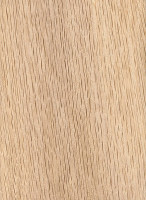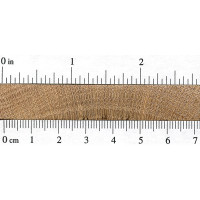 |
Common Name(s): Water Oak
Scientific Name: Quercus nigra Distribution: Eastern United States Tree Size: 50-80 ft (15-24 m) tall, 2-3 ft (.6-1 m) trunk diameter Average Dried Weight: 45 lbs/ft3 (725 kg/m3) Specific Gravity (Basic, 12% MC): .56, .73 Janka Hardness: 1,190 lbf (5,290 N) Modulus of Rupture: 16,620 lbf/in2 (114.6 MPa) Elastic Modulus: 2,034,000 lbf/in2 (14.02 GPa) Crushing Strength: 6,770 lbf/in2 (46.7 MPa) Shrinkage:Radial: 4.4%, Tangential: 9.8%, Volumetric: 16.1%, T/R Ratio: 2.2 |
Color/Appearance: Has a light to medium reddish-brown color, though there can be a fair amount of variation in color. Conversely, White Oak tends to be slightly more olive-colored, but is by no means a reliable method of determining the type of oak.
Grain/Texture: Has medium-to-large pores and a fairly coarse grain.
Rot Resistance: Red oaks such as Water Oak do not have the level of decay and rot resistance that White Oaks possess. Durability should be considered minimal.
Workability: Easy to glue, and takes stain and finishes very well.
Odor: Has a tell-tale smell that is common to most oaks. Most find it appealing.
Allergies/Toxicity: Although severe reactions are quite uncommon, oak has been reported as a sensitizer. Usually most common reactions simply include eye and skin irritation, as well as asthma-like symptoms. See the articles Wood Allergies and Toxicity and Wood Dust Safety for more information.
Pricing/Availability: Slightly less expensive than White Oak, Red Oak is in good/sustainable supply and is moderately priced. Thicker 8/4 planks, or quartersawn boards are slightly more expensive per board foot.
Sustainability: This wood species is not listed in the CITES Appendices or on the IUCN Red List of Threatened Species.
Common Uses: Cabinetry, furniture, interior trim, flooring, and veneer.
Comments: Water Oak falls into the red oak group, and shares many of the same traits as Red Oak (Quercus rubra). Red Oak, along with its brother White Oak, are commonly used domestic lumber species. Hard, strong, and moderately priced, Red Oak presents an exceptional value to woodworkers—which explains why it is so widely used in cabinet and furniture making.
- Black Oak (Quercus velutina)
- Bog Oak
- Brown Oak
- Bur Oak (Quercus macrocarpa)
- California Black Oak (Quercus kelloggii)
- Cherrybark Oak (Quercus pagoda)
- Chestnut Oak (Quercus prinus)
- English Oak (Quercus robur)
- Holm Oak (Quercus ilex)
- Japanese Oak (Quercus mongolica)
- Laurel Oak (Quercus laurifolia)
- Live Oak (Quercus virginiana)
- Oregon White Oak (Quercus garryana)
- Overcup Oak (Quercus lyrata)
- Pin Oak (Quercus palustris)
- Post Oak (Quercus stellata)
- Red Oak (Quercus rubra)
- Scarlet Oak (Quercus coccinea)
- Sessile Oak (Quercus petraea)
- Shumard Oak (Quercus shumardii)
- Southern Red Oak (Quercus falcata)
- Swamp Chestnut Oak (Quercus michauxii)
- Swamp White Oak (Quercus bicolor)
- Turkey Oak (Quercus cerris)
- White Oak (Quercus alba)
- Willow Oak (Quercus phellos)
 |
 |
 |
 |





My experience as an arborist and the occasional carpenter, is that Water Oak rots quicker than any other oak. It’s useless for lumber and makes poor firewood.
I have a little experience with water oak as firewood. Had to take down a small tree in a bad spot in my backyard. It seems to me that it takes a very long time to season. Has been nearly a year since I took down the tree and cut it into logs, it still burns like greenwood: sputters sap out of the ends.
Generic description does not note the unique grain of the water oak. But, you can see in the pictures. It has many short, dark flecks or stripes and gives a striking appearance. … I have a bo staff I bought on-line and later deduced from the grain that it is water oak.
Does anyone have much experience with water oak for firewood…trees that have been down 2 or 3 years?
Water oak is the most common oak species in my area of Atlanta. As an arborist and woodworker I look at a lot of nice big straight Quercus Nigra logs and wonder how the wood is favored among the oaks. All I have ever heard is that it is inferior to red and white. True or false? Is it less stable? Prone to checking, warping, bowing, twisting like they say? I have a beautiful 36″ log to saw and think I’ll give it a try. Reply?
Water Oak in Mississippi is plentiful. It is better for rough work like cross ties and pallets than Northern Red Oak or White Oak. It often checks and cracks. Trying to plane a 2″ thick slab will often result in only sawdust, as every pass results in some significant checks. You can turn small pieces, like chess pieces that look great, but not as easy to work with as White Oak. We do have a 12″ x 4″ x 8′ fireplace mantle made from an old piece my brother and I cut as teens. But, it has a significant crack… Read more »
I think they were bugs that bit you! You just couldn’t see them. Itch Mites Itch mites are a fairly new insect discovery, first noted in 2004, according to University of Nebraska at Lincoln Extension. They are microscopic insects that will bite humans causing itching and irritation. The oak leaf gall mite feeds on the larva of midges. More than 16,000 mites can fall from a single infected leaf, according to UNL Extension. The mites can land on people causing painful, itching bites. Mites need about four hours on a human before they start biting. Read more: Mites on Oak… Read more »
i have a water oak tree in my back yard and it ate my dog i swear it did and then my dad choped it down so it wouldnt eat me.
ok, this one time i was out campin g and there was nothing around so i sat under a tree and turns out it was a water oak tree and you know what it did……. IT BIT ME and there was no bug under me ya so that is my experience with water oak trees.